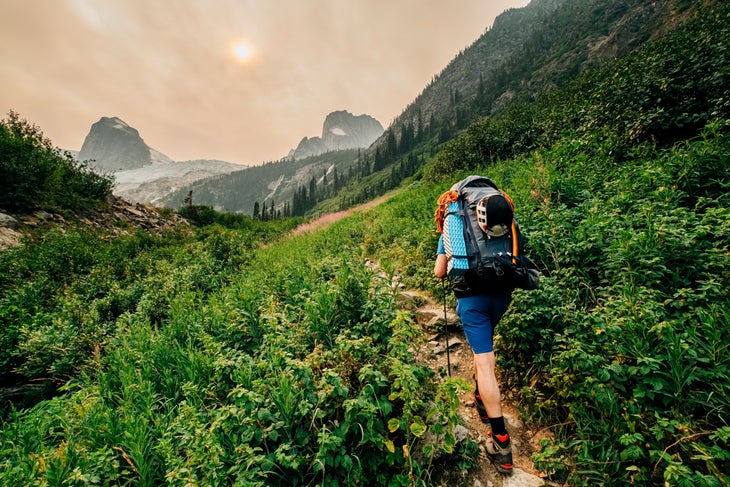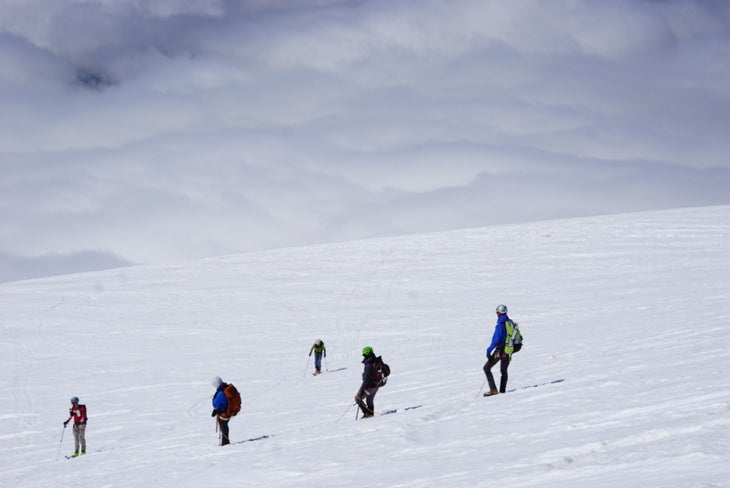Heading out the door? Read this article on the new Outside+ app available now on iOS devices for members! Download the app.
You’ve spent months planning for a hike, but once you hit the trail, nothing seems to go as planned. Maybe thunderheads loom in the distance. Maybe you forgot a crucial piece of gear. Or maybe you just have a sinking feeling in your gut. Part of you wants to press on so your planning won’t be for naught. But the other part of you isn’t sure it’s safe to keep going.
How do you know which voice to listen to? We talked to several hikers about all the different reasons they’ve turned around—or wished they had—during day hikes and overnight trips.
“Things happen, and being safe and getting home are the real end goal,” says Ally Watson, who has hiked the Pacific Crest Trail and spent 10 years working seasonal positions in National Parks.
Here are their seven totally valid reasons for ending a hike early and heading back to the trailhead.
Bad Weather
No matter how many times you check the forecast, unexpected weather conditions could foil your backpacking plans. A few years ago on the Great Divide Trail in the Canadian Rockies, Watson and her two hiking partners woke up to pouring rain with a long day above the treeline ahead of them.
“My partner’s feet had brushed the tent causing a steady flow of droplets to enter our tent all night,” she said, “The footbed of his sleeping bag was soaked, and I was fine.”
Without a window of sunshine to dry out, her partner would be dangerously cold and wet, a recipe for hypothermia. Luckily, a side trail led from their campsite to the highway. Following grizzly tracks the entire way, they hiked 1.5 hours through a hailstorm to the road, where they hitched a ride into the town of Jasper and warmed up in the community center’s hot tub.
“It was the best decision we made on that trail,” Watson said.

Wildfires Nearby
Smoke never bodes well. Oregonian Alex Houston and his partner had just started Section K of the PCT—a 125-mile stretch in Washington from Stevens Pass to Stehekin—in August 2021 when wildfire smoke shrouded their path. Several large fires burned in the Cascades, and while the vicinity wasn’t under any imminent fire risk, pushing through the smoke was incredibly unpleasant.
“It looked like it was gonna stick around pretty much for our whole trip, so we decided to bail after the first night and go hike somewhere that was more clear,” Houston said.
Had they been farther along, pivoting to Plan B would’ve been more logistically complicated. Even so, it was a tough call to make since they had been planning the trip for months, took off work, and staged cars at either ends of the trail. But what would be the point if they couldn’t even see the views on what many consider one of the trail’s most scenic sections?
“We felt it wasn’t worth toughing it out just for the sake of accomplishing our plans,” Houston said. Instead, they vowed to return another time when conditions would be more enjoyable.
Physical State
Even seemingly minor ailments such as blisters can grow and eventually hobble your hike. For thru-hiker Kylie Yang, it was a broken finger that ended her plans.
After two previous failed attempts, summer 2024 was going to be the year she completed the Wind River High Route with a hiking buddy. “Everything was aligning,” she said. But as they got deeper into the trail, it was harder than they thought. And on the second day, in the same spot where her other friend had gotten injured during her first attempt, Yang slipped in a talus field. She grabbed a rock for stability, which shifted a boulder, sending it rolling onto her finger.
With the digit broken and painfully swollen, Yang couldn’t even pack her bag herself; her hiking buddy had to help her. “We were both not having a good time,” she said. “Why push ourselves for another three days over kind of a long distance if we didn’t have to?” They decided that the pain and risk of further injury was not worth the achievement, and headed for their bailout point.
Mental State
Sometimes, even after all the anticipation and preparation, you’re just not feeling it. Yang says that for her, mental state going into a hike can either lead to the demise or success of a trip.
“I feel like I’m always juggling a number of factors when I’m thinking about this,” said Yang, who has pushed through plenty of mental barriers on the Appalachian Trail and other long hikes. She said that if two things are going badly—if she’s not feeling good and the weather is going to be bad—she’s more prone to turn around. The trail will still be there on a better day, she says.
“I work a full-time job,” Yang said. “I am tired. I am stressed. The last thing I want to be in the outdoors, especially in places that I love, is tired and stressed.”

Short Supplies
Without the right gear, even a hike that would otherwise be within your ability level may be more than you can handle. Over Memorial Day weekend in 2018, Neha Malhan planned to hike Mt. Baker in the North Cascades with two friends. Still early in the season, her friends anticipated adequate snow coverage with little melt and insisted they leave behind the rope and climbing supplies. “While I didn’t agree, I was outnumbered,” Malhan said.
But when they got up onto the mountain, they found the terrain treacherous and covered in crevasses. “All the other teams up there climbing were yelling at us about not having ropes,” she said.
Feeling uncomfortable and unsafe, Malhan decided to turn around and wait at their lunch spot while her friends continued on. In turning back though, she became lost and had to rope up with another team who helped her get back to the parking lot. Miraculously, she said, her friends returned safely too.
Moral of the story: Always pack essential safety gear, even if you think you don’t need it.
Trail Difficulty
You might have packed all the right gear, but if you don’t feel comfortable with the trail conditions, pushing on could mean assuming serious risk. That was the situation photographer Lauren Beane faced in August 2023, when she set out with two friends on the 26.5-mile Wallowa River Loop Trail, a remote trek in eastern Oregon.
They had been looking forward to the hike for years. After driving six hours from Portland, the group hiked seven miles to Aneroid Lake. On the second day, they set out early for an even longer day over Polaris Pass. But the three miles to the top of the pass—a total of 5,000 feet in elevation gain over the two days, higher than she’d ever ascended—took them much longer than expected.
“When we got up there and I looked over to the other side of the pass, my stomach dropped,” Beane said. Ahead was a narrow path traversing a steep hill of dirt and choss. Beane didn’t feel comfortable with the next section, and she spoke up.
“We just had a moment of, how does everyone feel about hiking down the other side of this pass?” she said. “If you fall, you’re falling for a while.” None of them thought continuing on was worth getting injured or rescued. So they vented their frustration, then turned around to Aneroid Lake, promising to return another year.
Group Needs
A chain is only as strong as its weakest link—and the proverb applies to hiking in groups, too. A few summers ago, Vivian Roberts, along with her brother, Cliff, and sister-in-law, Clair, planned a 3-day, 2-night trip to the Goat Rocks Wilderness in Washington. (The hike was already their backup plan; they snagged permits to do the Wonderland Trail but snowpack deterred them.)
“Cliff and I were both absolutely fired up to go hard and go far; this was one of the biggest trips of the year for both of us,” Roberts said. “Clair was less excited in general.” The sister-in-law was uncomfortable with the intense mosquitoes and the snowfields they first encountered.
On the first night, a weather system moved in. Heavy winds and rain led to a fitful night of sleep for all. Forecasts showed the cold lasting through the morning and burning off by the afternoon, but they needed good weather to hike the notorious Knife’s Edge. Cliff and Vivian wanted to wait out the cold. But Clair, who was freezing and could not warm up, had reached her limits.
Prioritizing Clair’s needs, they made the tough choice to turn around. To make up for it, Roberts booked a hotel. Plan C was rafting the Deschutes River the next day. “As a family, we needed to be able to support each other’s needs in less-than-ideal circumstances,” Roberts said.
From 2025